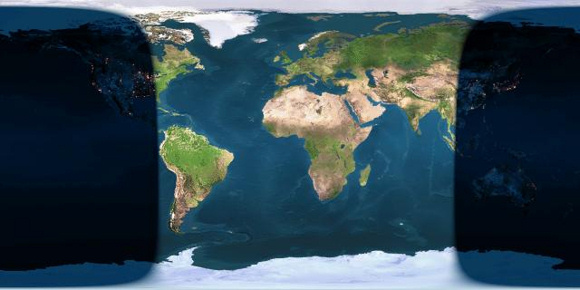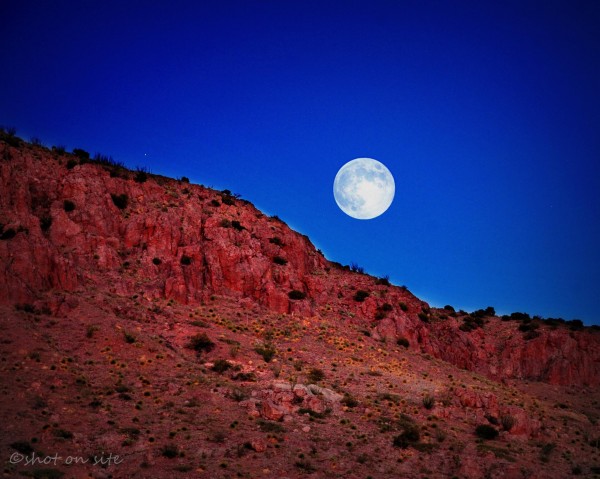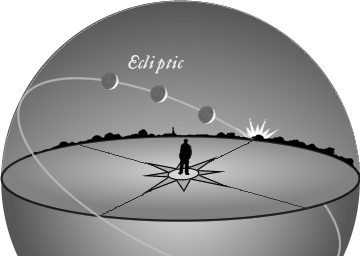In traditional skylore, the Harvest Moon is the full moon closest to the autumnal equinox. For us in the Northern Hemisphere, the 2013
autumnal equinox comes on September 22. That makes the September 18-19 full moon the Northern Hemisphere’s Harvest Moon … a bit of an early one for this year. Meanwhile, in Asia, this full moon falls on the night of September 19-20. Click the links below to learn more about the 2013 Harvest Moon.
Which night is the Harvest Moon for me?
Can I look for the Harvest Moon on other nights?
What makes a Harvest Moon special?
Is the Harvest Moon bigger, or brighter or more colorful?
Minor lunar standstill lessens impact of the Harvest Moon
How did the Harvest Moon get its name?
When is the Southern Hemisphere’s Harvest Moon?
What are some other full moon names?
When is the next Blue Moon?
Day and night sides of earth at instant of September 2013 full moon

Day and night sides of Earth at the instant of the September 2013 full moon (2013 September 19 at 11:13 Universal Time). Notice that dawn is coming to the U.S. while night is falling in Asia when the September 2013 moon reaches the crest of its full phase. Image credit:
Earth and Moon ViewerWhich night is the 2013 Harvest Moon for me? The Harvest Moon for 2013 falls on the night of September 18 or September 19, depending on your location on the globe. In North America, the crest of the moon’s full phase comes before sunrise September 19. at 11:13
UTC. That’s 6:13 a.m. central time in the U.S. on September 19, 2013.
Translate UTC to your time zone.So the night of September 18-19 has the brightest, fullest moon for the Americas. For us, by the night of September 19-20, the moon will be waning.
Meanwhile, in Asia, the moon turns full after sunset September 19. People in that region of the globe will call the night of September 19-20 the night of the full moon. In fact, September 19, 2013 is the night of the
Mid-Autumn Festival in Asia, which is linked to this full moon.
No matter where you are on Earth, this full moon – and every full moon – ascends over your eastern horizon around the time of sunset. It’s always highest in the sky in the middle of the night, when the sun is below your feet. That’s because a full moon is opposite the sun. Being opposite the sun, the moon is showing us its fully lighted hemisphere, or “day” side. That’s what makes the moon look full.

Harvest Moon rising above the Little Florida Mountains in Deming, New Mexico as seen by
EarthSky Facebookfriend Dan Gauss. Dan takes a photo of the full moon rising each month from this same spot.
See more favorite 2012 Harvest Moon photos here.Can I look for the Harvest Moon on other nights? Yes. No reason to limit the Harvest Moon fun to the nights of September 18-19 or 19-20. At middle and northerly latitudes in the Northern hemisphere, look for the moon to be bright and full-looking for several nights around September 18, 19 and 20. Around all of these nights, you’ll see a bright round moon in your sky, rising around the time of sunset, highest in the middle of the night. This procession of moonlit nights is what characterizes the Harvest Moon.
Want to know the time of moonrise in your location? My favorite source of that information is this
Custom Sunrise Sunset Calendar. Once you get to that page, be sure to click the box for ‘moon phases’ and ‘moonrise and moonset times.’

In autumn, the angle of the ecliptic – or sun and moon’s path – makes a narrow angle with the horizon. Image via classicalastronomy.com.

The narrow angle of the ecliptic means the moon rises noticeably farther north on the horizon, from one night to the next. So there is no long period of darkness between sunset and moonrise. Image via classicalastronomy.com.
What makes a Harvest Moon special? Harvest Moon is just a name. It’s the name for the full moon nearest the
autumnal equinox. In the Northern Hemisphere, the Harvest Moon sometimes falls in September and sometimes falls in October. But the Harvest Moon is more. Nature is particularly cooperative around the time of the autumn equinox to make the full moonrises unique around this time.
Here’s what happens. On average, the moon rises about 50 minutes later each day. But when a full moon happens close to the autumnal equinox, the moon (at mid-temperate latitudes) rises only about 30 to 35 minutes later daily for several days before and after the full Harvest moon. Why? The reason is that the
ecliptic – or the moon’s orbital path – makes a narrow angle with the evening horizon around the time of the autumn equinox. The narrow angle of the ecliptic results in a shorter-than-usual rising time between successive moonrises around the full Harvest Moon.
These early evening moonrises are what make every Harvest Moon special. Every full moon rises around sunset. After the full Harvest Moon, you’ll see the moon ascending in the east relatively soon after sunset for a few days in a row at northerly latitudes. The lag time between successive moonrises shrinks to a yearly minimum, as described in the paragraph above. Because of this, it seems as if there are several full moons – for a few nights in a row – around the time of the Harvest Moon.
Is the Harvest Moon bigger, or brighter or more colorful? The Harvest Moon is just an ordinary full moon. It isn’t really bigger or brighter or more colorful than any other full moon. But you might think that it is. Why?
It’s true that, in some months, the full moon is closer to us in orbit than others and so truly appears bigger. But the distance of the full moon depends on where the moon is in its orbit. There’s no correlation between each year’s Harvest Moon and the moon’s location in orbit (the actual full moon size). It’s different every year. The 2013 Harvest Moon is pretty close to an average-sized full moon. The
biggest full moon for 2013 falls in June. Nowadays, people call these close full moons a supermoon.
Still, you might think the Harvest Moon looks bigger or brighter or more orange. That’s because the Harvest Moon has such a powerful mystique. Many people look for it shortly after sunset around the time of full moon. After sunset around any full moon, the moon will always be near the horizon. It’ll just have risen. It’s the location of the moon near the horizon that causes the Harvest Moon – or any full moon – to look big and orange in color.
The orange color of a moon near the horizon is a true physical effect. It stems from the fact that – when you look toward the horizon – you are looking through a greater thickness of Earth’s atmosphere than when you gaze up and overhead. The atmosphere scatters blue light – that’s why the sky looks blue. The greater thickness of atmosphere in the direction of a horizon scatters blue light most effectively, but it lets red light pass through to your eyes. So a moon near the horizon takes on a yellow or orange or reddish hue.
The bigger-than-usual size of a moon seen near the horizon is something else entirely. It’s a trick that your eyes are playing – an illusion – called the Moon Illusion. You can find lengthy explanations of the Moon Illusion by googling those words yourself.
How did the Harvest Moon get its name? Why is this moon – the moon closest to the autumnal equinox – called the Harvest Moon?
The shorter-than-usual time between moonrises around the full Harvest Moon means no long period of darkness between sunset and moonrise for days in succession. In the days before tractor lights, the lamp of the Harvest Moon helped farmers to gather their crops, despite the diminishing daylight hours. As the sun’s light faded in the west, the moon would soon rise in the east to illuminate the fields throughout the night.
Who named the Harvest Moon? That name probably sprang to the lips of farmers throughout the Northern Hemisphere, on autumn evenings, as the Harvest Moon aided in bringing in the crops. The name was popularized in the early 20th century by the song below.
Shine On Harvest Moon
By Nora Bayes and Jack Norworth (1903)
Shine on, shine on harvest moon
Up in the sky,
I ain’t had no lovin’
Since January, February, June or July
Snow time ain’t no time to stay
Outdoors and spoon,
So shine on, shine on harvest moon,
For me and my gal.
When is the Southern Hemisphere’s Harvest Moon? For the Southern Hemisphere, the autumn equinox falls in March. So the Southern Hemisphere always has a full moon with these same characteristics – rising shortly after sunset for several nights in a row – in March or April.
What are some other full moon names? Every full moon has a name. The names vary in cultures around the world, and they particularly vary between the Northern and Southern Hemispheres. One of the most famous full moon names – other than Harvest Moon – is Hunter’s Moon. That’s the name for the full moon after the Harvest Moon. For the Northern Hemisphere, this year’s Hunter’s Moon comes on October 18.
Read more about full moon names here.Bottom line: The Harvest Moon in 2013 comes on the night of September 18-19 for us in the U.S. It falls on the night of September 19-20 in Asia. The Harvest Moon is the full moon closest to the autumnal equinox, which in 2013 comes on September 22. The exact time offullest full moon for this month is September 19 at 11:13 UT, or 6:19 a.m. CDT in the central U.S. The night of September 18, 2013 will have a beautiful bright full-looking moon, as seen from around the globe. So will the night of September 19, 2013. The Harvest Moon is not really bigger, brighter or more pumpkin-colored than other full moons, but it’s special because, at this time of year in the Northern Hemisphere, the time between successive moonrises – from one night to the next – is shorter than usual. Enjoy!
Article Source:
http://earthsky.org/space/harvest-moon-2
 Hemp Seed Protein Powder is among the most concentrated protein sources of all the plant foods, and it’s a complete protein source – offering all the essential amino acids. Navitas Naturals Hemp Powder is 50% protein, and it is protein in an easy-to-digest form. It is also a healthy source of dietary fiber, chlorophyll, and minerals including magnesium, iron, zinc and potassium. This finely milled powder has a rich, nutty flavor that is ideal for smoothies, baked goods or any recipe that could use a protein and fiber boost.
Hemp Seed Protein Powder is among the most concentrated protein sources of all the plant foods, and it’s a complete protein source – offering all the essential amino acids. Navitas Naturals Hemp Powder is 50% protein, and it is protein in an easy-to-digest form. It is also a healthy source of dietary fiber, chlorophyll, and minerals including magnesium, iron, zinc and potassium. This finely milled powder has a rich, nutty flavor that is ideal for smoothies, baked goods or any recipe that could use a protein and fiber boost.












